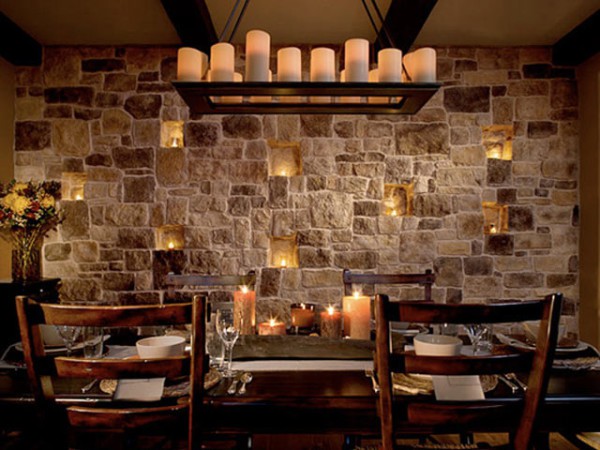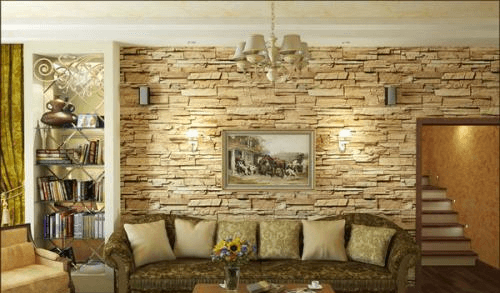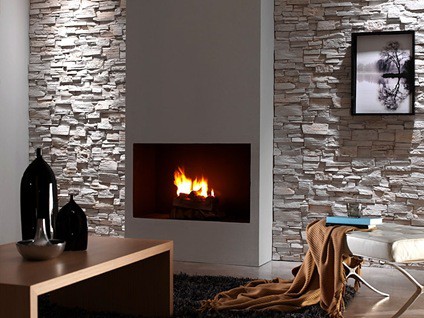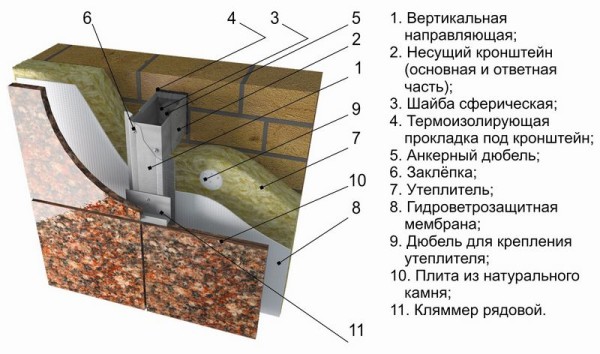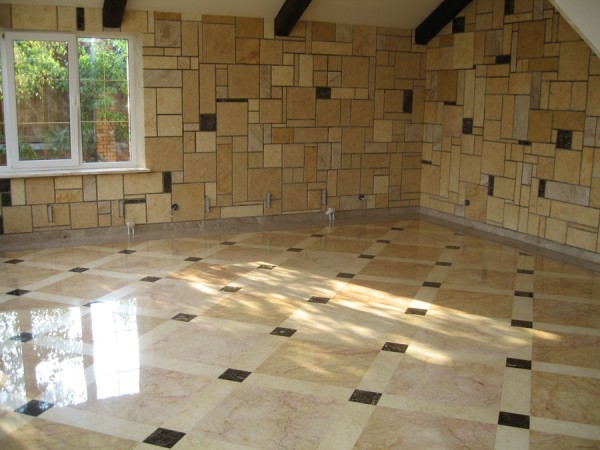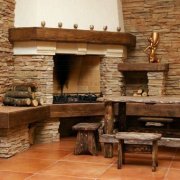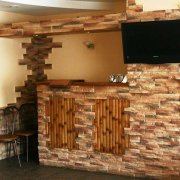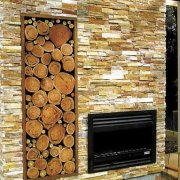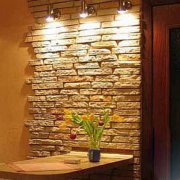Stone Finish: Interior Features
Finishing work has always helped in the interior of the room to add some zest and make it very original. For this reason, stone finish is a fairly common option.
It is unusual and can be done with a lot of material.
The content of the article
Stylistic trends with stone trim
Under the stone, the interior has been used for many centuries. If previously there was a slightly limited amount of materials used in the finishing work, then at the moment there is a large selection of interior decoration with stone trim.
Quite often, stone trim is used in:
- Classic style.
- Baroque.
- High tech.
- Country and more.
Material can be completely decorated the entire surface, and its individual part. It goes well with decorative plaster or wood finishes.
What materials can be used in stone finishing
Finishing a house under a stone can be external and internal.
It uses similar materials:
- Decorative rock.
- Natural sinter.
- Ceramics under the stone.
- Polypropylene masonry panels.
See photos of examples of room decoration using these materials.
Decorative stone in decorating and its advantages
Main advantage artificial stone there will be its exact similarity to the appearance of natural agglomerate. In cost, both the material have significant differences, but have almost the same properties.
Decorative rock:
- Practical and durable, as its surface is not exposed to moisture and is not able to absorb a variety of contaminants.
- Reliable and durable, able to withstand significant loads, which makes it possible to mount various elements of the decor of the room on it.
- Easy to install, as the principle of operation is similar to the installation of ordinary ceramic tiles.
- Wearproof and has a reliable surface.
- It withstands exposure to sharp temperature extremes.
Tip.
The surface of an artificial stone can only be cleaned with mild detergents using a foam sponge or a simple rag. It is better not to use abrasives so as not to violate the top layer of material protection.
Types of decorative stone used in decoration
At the moment there are several types of artificial stone, which is quite widely used in the decoration of rooms:
- Gypsum.
- Acrylic.
- Cement-sand with the addition of crumbs of natural agglomerate.
- From synthetic fibers with the addition of binders.
Characteristics of materials:
- The most popular today is gypsum decorative stone. This is due to the fact that the price is quite low, and the quality, properties and characteristics remain at their best.
- In most cases, artificial stone is used to decorate living rooms, fireplaces, and kitchen areas.
Tip.
This finishing material should not be used to design a kitchen apron, since its surface cannot be cleaned with rough abrasive products. It can easily be damaged and all this will ruin the appearance of the finish.
Natural stone in decorating
Natural sinter has become popular relatively recently. Its cost is slightly more than an artificial analogue. But it has a wider range of applications and special durability.
The following types of stones are used in the decoration of the room:
- Onyx.
- Marble.
- Granite.
- Sandstone.
Note. The most durable are marble and granite.
They can be in plates or separate decorative plates. They are used in exterior and interior decoration. Mounting such material is quite simple. But for this you need to initially prepare the surface for work.
A natural stone:
- Practical and durable - the average life of the finish is at least 10-20 years.
- The surface is moisture-proof and wear-resistant, it is not exposed to fading and abrasion.
- There is a large selection of colors and sizes of the material, which makes it possible to use it in any room and on any surface.
- Its strength is very high, as it does not undergo a too long processing process.
- Able to withstand significant loads.
When choosing such a material for finishing work, it is worth considering that it has considerable weight and for its high-quality installation it is necessary to pre-prepare the surface.
For this, the instruction does not exist. It’s just that there are recommendations of specialists who will help to perform all the actions qualitatively.
Surface preparation for the installation of natural sinter
Preparatory work on the surface consists in leveling it if necessary and strengthening.
There are two ways to level the surface for natural stone:
- Stucco.
- Drywall.
Concrete mortar, which has high strength and reliability, is rarely used.
To prepare it you will need:
- Water.
- Cement.
- Sand (small amount).
Stages:
- With drywall, which is mounted on a frame made of profiles and plaster applied in several layers, everything is clear.
To do this, you do not need to have skills in work. It’s enough just to have an idea of the work performed. - With cement mortar, everything happens a little bit wrong. It is kneaded in a concrete mixer or a large capacity tank.
Tip. If the area of finishing works is large, it will be more efficient to use a concrete mixer, which will save both time and effort.
- Sand can not be used in solution.
- Since natural stone has a large weight, the surface, in addition to leveling, needs to be strengthened. For this, wire reinforcement mesh is used.
It is mounted in layers of cement mortar or plaster. If drywall is used, then a layer of plaster is applied to it and a grid is mounted in it.
Tip.
It is worth considering that the drywall is mounted on the frame and is able to withstand not too large loads. If you put a dense layer of plaster with reinforcing mesh on it, and then also a natural finishing material, then it may not be able to withstand this - it will begin to deform and violate the appearance of the finish.
Surface mounted natural stone
If the surface is prepared efficiently, then in such works there is nothing complicated and there is an opportunity to do all the actions with your own hands.
For this you need:
- Cement mortar.
- Master OK.
- Building level.
- Tile cutter for fitting material sizes.
So:
- Initially, a layer of cement mortar is applied to the surface and slabs are recessed into it. natural stone.
Tip.Such actions must be performed carefully so that the surface of the stone peeks slightly above the solution.
The distance between the stones and the type of their masonry is chosen by each independently. It all depends on the design of the design of the building.
Ceramics under the stone for decoration
Ceramic tiles currently have a wide range of applications.
It has a large selection of design, including imitation of natural stone, brick and much more. There are also different sizes.
It has excellent properties:
- Durable.
- Practical.
- Reliable.
- Durable
- Moisture resistant.
- Wear resistant.
- Frost resistant.
- It is not able to fade in direct sunlight due to the good protective layer on the surface.
Tip. You can use ceramic tiles like stone not only in rooms with sharp changes in temperature and high humidity, but also in other rooms for their original design.
The cost of this material is not too high, which ensures great demand for it. Fixing ceramic tiles is a very simple process. It is performed only on a flat surface using special tools.
A tile may have a different surface:
- Matte.
- Glossy.
- Embossed.
- Glazed (special shine).
Thanks to this, you can use the material to create a unique interior of the room.
Ceramic Tips
Particular attention should be paid to the quality of the material. If the tile is too cheap, then its quality will not be at a high level.
So:
- Choosing is worth the average cost, where the quality will correspond to the cost.
- The corners of the ceramic tile must be even and not have any deformation in one direction. That is, they must be in the same plane with the surface of the material.
If it is possible to see where the tile was stored, then it will already be possible to draw a conclusion about its properties, which may change as a result of improper storage.
Surface mounted ceramic tiles
To install ceramic tiles under the stone is not difficult, since it does not have a large size.
For such work you will need:
- Special agent (glue) or cement mortar.
- Building level for even installation.
- Tile cutter for cutting ceramics.
- Tape measure and pencil.
- Cruciform lighthouses (if necessary).
Tip. In the installation of ceramic tiles, one must take into account that the structure constantly gives a slight shrinkage. It is because of this that each element of decoration needs to be fixed at a certain distance from each other, the uniformity of which is ensured by cross-shaped beacons.
Watch the video on installing ceramic tiles under the stone. There are some nuances in the work that may not be known to the layman.
After the installation of ceramics on the surface is already completed, it remains only to qualitatively mask the joints between each tile. For this, a decorative putty of a certain shade is used.
In order not to use it, you can add a coloring pigment to the glue or cement solution.
